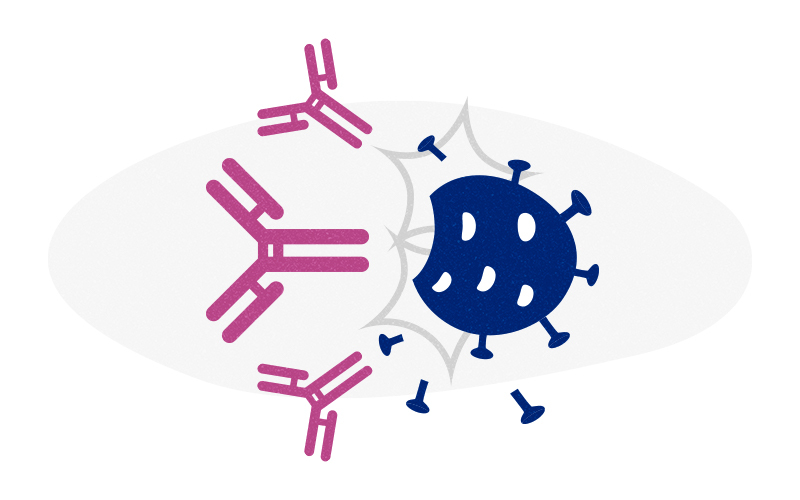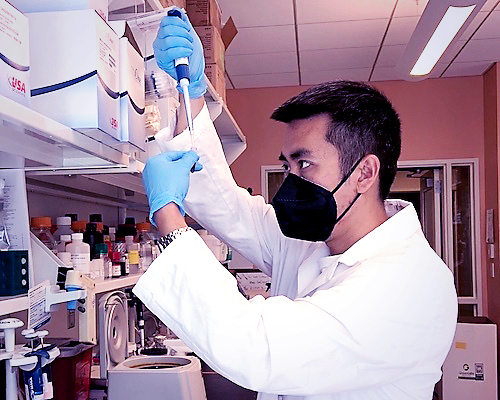How protected am I from COVID-19? A new test could tell you at home

Say you’re going to a wedding or a concert or are about to leave the country. You’ve been vaccinated against COVID-19, even boosted, but you have an underlying medical condition. You might have a young child who’s received only one vaccine dose. How much protection do you and your family have? Do you need another booster?
If validated and approved, a new rapid test could give you the answer at home or on the spot at your health care provider’s office.
Dr. Hojun Li, an attending physician at Dana-Farber/Boston Children’s Cancer and Blood Disorders Center, got the idea when he had to clear a child with a brain tumor to receive a stem cell transplant. It was March 2020, just as COVID-19 was beginning to shut the world down.

“The patient came in with a sniffle and cough, and a family member was sick at home,” Dr. Li recalls. “We had no idea if it was coronavirus; testing at the time was very limited. And here we were about to possibly send a patient into transplant, which would require us to wipe out his immune system. I had to be the one to say no; it was too risky.”
Eventually, the child received the transplant he desperately needed. But only after a week-long wait for a negative PCR test and resolution of his cold-like symptoms. Dr. Li wondered: Why is testing so limited, and what other tests will we need to beat this pandemic? Could a rapid test be developed to tell how much immunity someone has to COVID-19?
A home test for COVID-19 neutralizing antibodies
At the time, most scientists were seeking tests that could tell if someone had active, contagious COVID-19. Those efforts led to the home antigen tests we use today. Dr. Li instead decided to focus on tests for neutralizing antibodies. These indicate whether someone has developed protective immunity to a virus, through either direct exposure or vaccination.
Such tests did exist, but they needed trained personnel and labs with specialized equipment. Dr. Li wanted a quick, accurate test that anyone could use. Lacking experience with test development, he reached out to experts Dr. Hadley Sikes and Dr. Sangeeta Bhatia at MIT. After initial discussions, Dr. Li enlisted research technicians Guinevere Connelly and Orville Kirkland. Both are members of the lab he leads at MIT’s Koch Institute for Integrative Cancer Research.
After several attempts, the team came up with a simple test kit using paper strips, inspired by home pregnancy tests. Users would mix a drop of their blood from a finger prick with a solution containing a fragment of the coronavirus spike protein. This fragment, called RBD, is what the virus uses to invade our cells, latching on to ACE2 receptors.
Next, users would place a few drops of this mixture on the test strip and wait 15 minutes, watching for two lines on the strip. One line simply picks up free-floating viral RBD protein from the solution. The second line is critical: It picks up antibodies that have neutralized RBD, blocking its ability to initiate infection. The stronger this line, the higher the neutralizing antibody levels and the better the protection against COVID-19.
Putting the test through its paces
To evaluate the new test’s performance, Dr. Li and his colleagues used it on blood samples from 63 people who had been infected with the coronavirus and 30 who had not. In those who had been infected, investigations found that the test detected neutralizing antibodies with accuracy similar to that of existing laboratory tests.
“The initial tests that flooded the market in 2020 identified any antibody that bound to any part of the spike protein, regardless of whether the antibody would actually block infection,” notes Dr. Li. “Those tests turned out to not be very accurate.”
In a second round, the team tested 30 samples taken from two people before COVID-19 vaccination and at several time points afterward. The level of neutralizing antibodies peaked around seven weeks after the first vaccine dose, then began to slowly decline.
People who cannot mount a good immune response could test themselves more frequently and perhaps get more frequent boosters.
Dr. Li believes that the RBD protein could be updated as new coronavirus variants emerge, keeping the test current. He envisions a smartphone camera app that would help interpret the results by measuring the intensity of the two test lines.
Safe to mingle?
The team hopes to partner with a company that could manufacture the test kit in bulk and obtain approval from the Food and Drug Administration. If it reaches the marketplace, people could use the test to check their level of immunity before traveling or attending large events, especially if they are at increased risk for COVID-19 and its complications.
“People who cannot mount a good immune response could test themselves more frequently and perhaps get more frequent boosters,” Dr. Li speculates. “I could also see health officials using this test to measure general rates of immune protection in a community. This knowledge might be useful for decisions about whether public health restrictions or policies are necessary.”
Learn more about COVID-19 research at Boston Children’s.
Related Posts :
-

A COVID-19 DNA nanoswitch: A new kind of test for a new kind of virus
When the COVID-19 pandemic shut down research laboratories across the country, several labs at Boston Children’s Hospital geared up, ...
-

A new symptom of COVID-19 in young children: Croup
During the Omicron surge, pediatricians and emergency departments (EDs) began noticing something new: a surge in croup among infants and ...
-

Capturing SARS-CoV-2's shape-shifting spike protein
The rod-like spike proteins on the surface of SARS CoV-2 are the tip of the spear of the COVID-19 pandemic. ...
-

Why do some people get severe COVID-19? The nose may know
The body’s first encounter with SARS-CoV-2, the virus behind COVID-19, happens in the nose and throat, or nasopharynx. A ...





